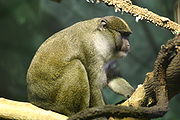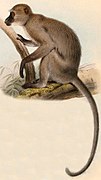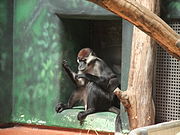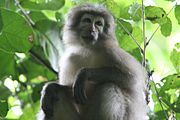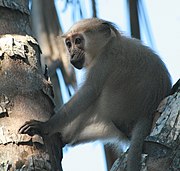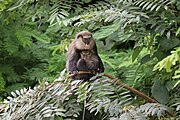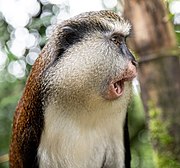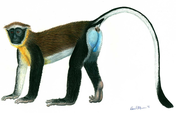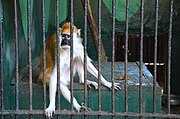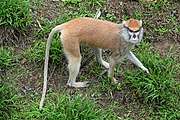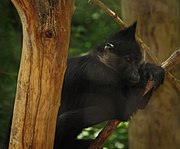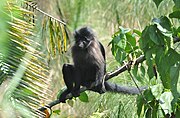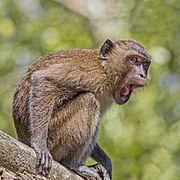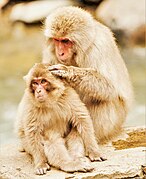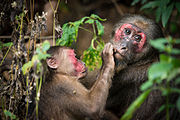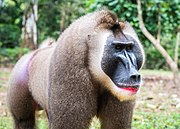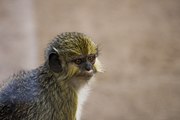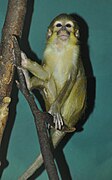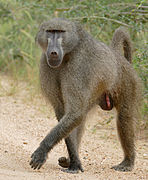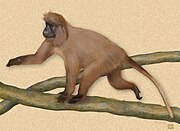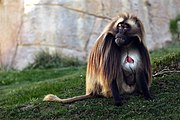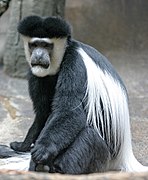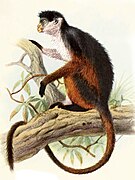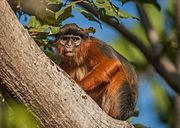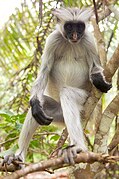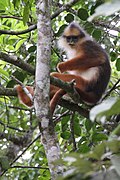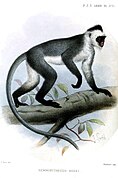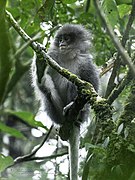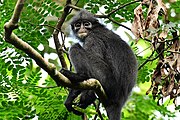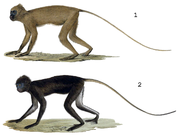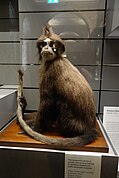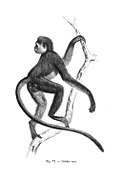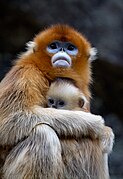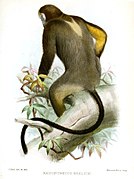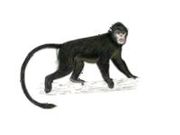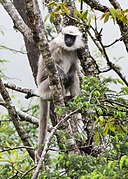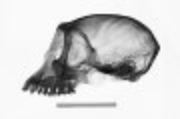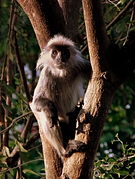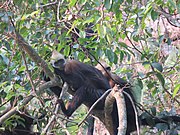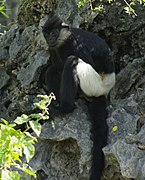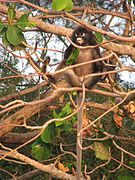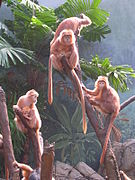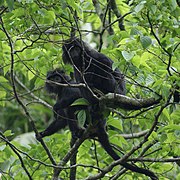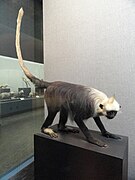List of cercopithecoids

The 158
Conventions
| Critically Endangered (26 species) | |
| EN | Endangered (49 species) |
|---|---|
| VU | Vulnerable (39 species) |
| NT | Near threatened (17 species) |
| LC | Least concern (25 species) |
| Other categories | |
| DD | Data deficient (2 species) |
| NE | Not evaluated (0 species) |
Conservation status codes listed follow the International Union for Conservation of Nature (IUCN) Red List of Threatened Species. Range maps are provided wherever possible; if a range map is not available, a description of the cercopithecoid's range is provided. Ranges are based on the IUCN Red List for that species unless otherwise noted. All extinct genera, species, or subspecies listed alongside extant species went extinct after 1500 CE, and are indicated by a dagger symbol "†".
Classification
The superfamily
Subfamily Cercopithecinae
- Genus Allenopithecus(Allen's swamp monkey): one species
- Genus Allochrocebus (terrestrial guenons): three species
- Genus Cercocebus(white-eyelid mangabeys): seven species
- Genus Cercopithecus(guenons): nineteen species
- Genus Chlorocebus (vervet monkeys): seven species
- Genus Erythrocebus (patas monkeys): three species
- Genus Lophocebus(crested mangabeys): two species
- Genus Macaca(macaques): twenty-four species
- Genus Mandrillus (mandrills): two species
- Genus Miopithecus(talapoins): two species
- Genus Papio(baboons): six species
- Genus Rungwecebus(kipunji): one species
- Genus Theropithecus (gelada): one species
Subfamily Colobinae
- Genus Colobus(black-and-white colobuses): five species
- Genus Nasalis(proboscis monkey): one species
- Genus Piliocolobus(red colobuses): fifteen species
- Genus Presbytis (surilis): nineteen species
- Genus Procolobus(olive colobus): one species
- Genus Pygathrix(doucs): three species
- Genus Rhinopithecus(snub-nosed monkeys): five species
- Genus Semnopithecus (gray langurs): eight species
- Genus Simias(pig-tailed langur): one species
- Genus Trachypithecus (lutungs): twenty-one species
|
Cercopithecoids
The following classification is based on the taxonomy described by the reference work Mammal Species of the World (2005), with augmentation by generally accepted proposals made since using molecular phylogenetic analysis, as supported by both the IUCN and the American Society of Mammalogists.[3]
Subfamily Cercopithecinae
| Common name | Scientific name and subspecies | Range | Size and ecology | IUCN status and estimated population |
|---|---|---|---|---|
| Allen's swamp monkey | A. nigroviridis (Pocock, 1907) |
Central Africa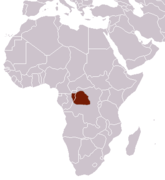
|
Size: 33–51 cm (13–20 in) long, plus 35–52 cm (14–20 in) tail[4] Habitat: Forest[5] Diet: Fruit, leaves, and small invertebrates[6] |
LC
|
| Common name | Scientific name and subspecies | Range | Size and ecology | IUCN status and estimated population |
|---|---|---|---|---|
| L'Hoest's monkey | A. lhoesti P. L. Sclater, 1899 |
Central Africa
|
Size: 31–69 cm (12–27 in) long, plus 48–10 cm (19–4 in) tail[7] Habitat: Forest[8] Diet: Fruit, leaves, mushrooms, and invertebrates[7] |
VU
|
| Preuss's monkey | A. preussi Matschie, 1898 Two subspecies
|
West-central Africa
|
Size: 45–61 cm (18–24 in) long, plus 49–69 cm (19–27 in) tail[9] Habitat: Forest and grassland[10] Diet: Fruit, seeds, shoots, leaves, buds, flowers, and mushrooms[9] |
EN
|
| Sun-tailed monkey | A. solatus M. J. S. Harrison, 1988 |
West-central Africa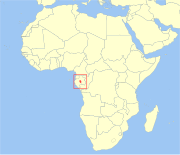
|
Size: 45–58 cm (18–23 in) long, plus 56–76 cm (22–30 in) tail[11] Habitat: Forest[12] Diet: Fruit, seeds, and invertebrates[11] |
NT
|
| Common name | Scientific name and subspecies | Range | Size and ecology | IUCN status and estimated population |
|---|---|---|---|---|
| Agile mangabey | C. agilis (H. Milne-Edwards, 1886) |
Central Africa
|
Size: 44–65 cm (17–26 in) long, plus 45–79 cm (18–31 in) tail[13] Habitat: Forest[14] Diet: Fruit, seeds and shoots, as well as small vertebrates[14] |
LC
|
| Collared mangabey | C. torquatus (Kerr, 1792) |
Western Africa
|
Size: 45–67 cm (18–26 in) long, plus 60–75 cm (24–30 in) tail[15] Habitat: Forest[16] Diet: Fruit and nuts, as well as stems and roots[15] |
EN
|
| Golden-bellied mangabey | C. chrysogaster Lydekker, 1900 |
Central Africa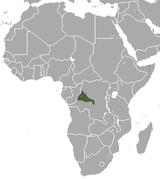
|
Size: 40–80 cm (16–31 in) long, plus 45–100 cm (18–39 in) tail[17] Habitat: Forest[18] Diet: Invertebrates, fruit, seeds, and nectar[17] |
EN
|
| Sanje mangabey | C. sanjei Mittermeier, 1986 |
East-central Africa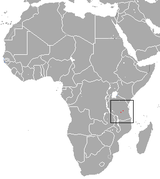
|
Size: 50–65 cm (20–26 in) long, plus 55–65 cm (22–26 in) tail[19] Habitat: Forest[20] Diet: Fruit, nuts, and seeds, as well as fungi, invertebrates, and plants[20] |
EN
|
| Sooty mangabey | C. atys (Audebert, 1797) |
Western Africa | Size: 40–68 cm (16–27 in) long, plus 40–80 cm (16–31 in) tail[21] Habitat: Forest and savanna[22] Diet: Fruit and nuts, as well as swamp plants, grass, seeds, fungi, and invertebrates[21] |
VU
|
| Tana River mangabey | C. galeritus Peters, 1879 |
Eastern Africa
|
Size: 44–63 cm (17–25 in) long, plus 50–68 cm (20–27 in) tail[23] Habitat: Forest, shrubland, and inland wetlands[24] Diet: Fruit and seeds, as well as stems, leaves, insects, and fungi[23] |
CR
|
| White-naped mangabey | C. lunulatus (Temminck, 1853) |
Western Africa
|
Size: 52–73 cm (20–29 in) long, plus 68–74 cm (27–29 in) tail[15] Habitat: Forest and inland wetlands[25] Diet: Fruit, leaves, seeds, buds, and grass[26] |
EN
|
| Common name | Scientific name and subspecies | Range | Size and ecology | IUCN status and estimated population |
|---|---|---|---|---|
| Blue monkey | C. mitis Wolf, 1822 Sixteen subspecies
|
Sub-Saharan Africa
|
Size: 31–70 cm (12–28 in) long, plus 55–109 cm (22–43 in) tail[27] Habitat: Forest[28] Diet: Fruit and leaves, as well as invertebrates[29] |
LC
|
| Campbell's mona monkey | C. campbelli Waterhouse, 1838 |
Western Africa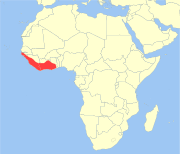
|
Size: 36–55 cm (14–22 in) long, plus 49–85 cm (19–33 in) tail[30] Habitat: Forest, savanna, and shrubland[31] Diet: Fruit, leaves, seeds and grains, as well as birds, bird eggs, small reptiles, and insects[30] |
NT
|
| Crested mona monkey | C. pogonias Bennett, 1833 Three subspecies
|
Central Africa
|
Size: 34–55 cm (13–22 in) long, plus 48–87 cm (19–34 in) tail[32] Habitat: Forest[33] Diet: Fruit and seeds, as well as leaves, flowers and insects[33] |
NT
|
| De Brazza's monkey | C. neglectus Schlegel, 1876 |
Central Africa
|
Size: 39–60 cm (15–24 in) long, plus 47–79 cm (19–31 in) tail[34] Habitat: Inland wetlands and forest[35] Diet: Fruit, as well as leaves, flowers, mushrooms, beetles, termites, and worms[36] |
LC
|
| Dent's mona monkey | C. denti Thomas, 1907 |
Central Africa
|
Size: 40–70 cm (16–28 in) long, plus 70–90 cm (28–35 in) tail[37] Habitat: Forest[38] Diet: Fruit and arthropods, as well as flowers, caterpillars, shoots, and leaves[38] |
LC
|
| Diana monkey | C. diana (Linnaeus, 1758) |
Western Africa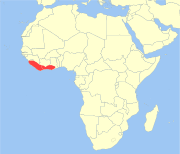
|
Size: 40–55 cm (16–22 in) long, plus 50–75 cm (20–30 in) tail[39] Habitat: Forest[40] Diet: Fruit, flowers, leaves, insects, and other invertebrates[39] |
EN
|
| Greater spot-nosed monkey | C. nictitans (Linnaeus, 1766) Five subspecies
|
Western Africa
|
Size: 40–57 cm (16–22 in) long, plus 56–100 cm (22–39 in) tail[41] Habitat: Forest[42] Diet: Fruits and seeds, as well as leaves and insects[43] |
NT
|
| Hamlyn's monkey | C. hamlyni Pocock, 1907 Two subspecies
|
Central Africa
|
Size: 43–63 cm (17–25 in) long, plus 49–63 cm (19–25 in) tail[44] Habitat: Forest[45] Diet: Shoots, leaves, plants, and herbs, as well as fruit and seeds[46] |
VU
|
| Lesser spot-nosed monkey | C. petaurista (Schreber, 1774) Two subspecies
|
Western Africa
|
Size: 29–53 cm (11–21 in) long, plus 57–78 cm (22–31 in) tail[47] Habitat: Forest[48] Diet: Fruit as well as insects[47] |
NT
|
| Lesula | C. lomamiensis Hart et al., 2012 |
Central Africa
|
Size: 40–65 cm (16–26 in) long, plus 40–65 cm (16–26 in) tail[49] Habitat: Forest[50] Diet: Leaves, fruits and flowers[51] |
VU
|
| Lowe's mona monkey | C. lowei Thomas, 1923 |
Western Africa (in green)
|
Size: 36–55 cm (14–22 in) long, plus 54–85 cm (21–33 in) tail[52] Habitat: Forest and savanna[53] Diet: Fruit and insects[52] |
VU
|
| Mona monkey | C. mona (Schreber, 1774) |
Western Africa
|
Size: 32–53 cm (13–21 in) long, plus 67–90 cm (26–35 in) tail[54] Habitat: Forest[55] Diet: Fruit, sprouts, leaves, and invertebrates[54] |
NT
|
| Moustached guenon | C. cephus (Linnaeus, 1758) Three subspecies
|
Western Africa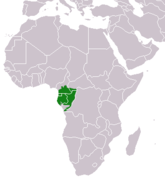
|
Size: 44–60 cm (17–24 in) long, plus 66–99 cm (26–39 in) tail[56] Habitat: Forest[57] Diet: Fruit, as well as seeds, leaves, insects, and eggs[58] |
LC
|
| Red-eared guenon | C. erythrotis Waterhouse, 1838 Two subspecies
|
Western Africa
|
Size: 36–55 cm (14–22 in) long, plus 46–77 cm (18–30 in) tail[59] Habitat: Forest[60] Diet: Fruit, as well as leaves, shoots and arthropods[60] |
VU
|
| Red-tailed monkey | C. ascanius (Audebert, 1799) Five subspecies
|
Central Africa
|
Size: 34–55 cm (13–22 in) long, plus 67–92 cm (26–36 in) tail[61] Habitat: Forest[62] Diet: Fruit, as well as leaves, insects, flowers, buds, and tree gum[63] |
LC
|
| Roloway monkey | C. roloway (Schreber, 1774) |
Western Africa
|
Size: 44–62 cm (17–24 in) long, plus 70–91 cm (28–36 in) tail[64] Habitat: Forest[65] Diet: Insects, as well as seeds, fruit, and leaves[64] |
CR
|
| Sclater's guenon | C. sclateri Pocock, 1904 |
Western Africa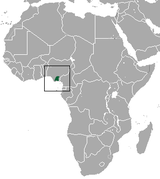
|
Size: 32–38 cm (13–15 in) long, plus 61–85 cm (24–33 in) tail[66] Habitat: Forest[67] Diet: Fruit, as well as insects, flowers and leaves[68] |
EN
|
| White-throated guenon | C. erythrogaster Gray, 1866 Two subspecies
|
Western Africa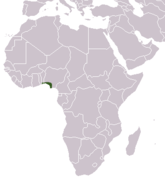
|
Size: 38–46 cm (15–18 in) long, plus 58–70 cm (23–28 in) tail[47] Habitat: Forest and inland wetlands[69] Diet: Fruit[69] |
EN
|
| Wolf's mona monkey | C. wolfi (Meyer, 1891) Three subspecies
|
Central Africa | Size: 44–52 cm (17–20 in) long, plus 69–83 cm (27–33 in) tail[70] Habitat: Forest[71] Diet: Fruit, leaves, seeds, and flowers[70] |
NT
|
| Common name | Scientific name and subspecies | Range | Size and ecology | IUCN status and estimated population |
|---|---|---|---|---|
| Bale Mountains vervet | C. djamdjamensis Neumann, 1902 Two subspecies
|
Eastern Africa
|
Size: 43–45 cm (17–18 in) long, plus 47–50 cm (19–20 in) tail[72] Habitat: Forest[73] Diet: Leaves and fruit, as well as flowers, small vertebrates, shoots, stems, and roots[74] |
VU
|
| Dryas monkey | C. dryas (Schwarz, 1932) |
Central Africa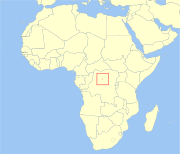
|
Size: 36–40 cm (14–16 in) long, plus 48–52 cm (19–20 in) tail[75] Habitat: Forest[76] Diet: Fruit, leaves, shoots, pith, seeds, insects, and mushrooms[76] |
EN
|
| Green monkey | C. sabaeus (Linnaeus, 1766) |
Western Africa
|
Size: 42–46 cm (17–18 in) long, plus 42–72 cm (17–28 in) tail[72] Habitat: Forest and savanna[77] Diet: Fruit and leaves[78] |
LC
|
| Grivet | C. aethiops (Linnaeus, 1758) Two subspecies
|
Eastern Africa
|
Size: 40–60 cm (16–24 in) long, plus 30–50 cm (12–20 in) tail[79] Habitat: Savanna and shrubland[80] Diet: Fruit, insects, and vegetable matter, as well as small mammals and birds[79] |
LC
|
| Malbrouck | C. cynosuros (Scopoli, 1786) |
Southern Africa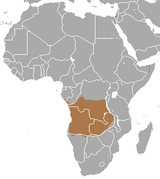
|
Size: 34–70 cm (13–28 in) long, plus 44–79 cm (17–31 in) tail[81] Habitat: Forest and savanna[82] Diet: Fruit, as well as shoots, stems, gum, and seeds[81] |
LC
|
| Tantalus monkey | C. tantalus (Ogilby, 1841) Three subspecies
|
Equatorial Africa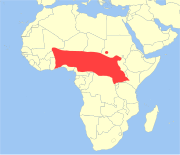
|
Size: 38–83 cm (15–33 in) long, plus 55–114 cm (22–45 in) tail[83] Habitat: Forest and savanna[84] Diet: Fruit, buds, seeds, roots, bark, and gum, as well as insects, small vertebrates and eggs[83] |
LC
|
| Vervet monkey | C. pygerythrus F. Cuvier, 1821 Five subspecies
|
Eastern and southern Africa
|
Size: 42–57 cm (17–22 in) long, plus 48–75 cm (19–30 in) tail[83] Habitat: Savanna, shrubland, and forest[85] Diet: Leaves, flowers, fruit, seeds, arthropods, and gum[86] |
LC
|
| Common name | Scientific name and subspecies | Range | Size and ecology | IUCN status and estimated population |
|---|---|---|---|---|
| Blue Nile patas monkey | E. poliophaeus Reichenbach, 1862 |
Eastern Africa | Size: 49–64 cm (19–25 in) long, plus 43–73 cm (17–29 in) tail[87] Habitat: Forest, savanna, and shrubland[88] Diet: Gum and arthropods, as well as flowers, fruit, seeds, leaves, stems, roots, and small vertebrates[87] |
DD
|
| Common patas monkey | E. patas (Schreber, 1775) Three subspecies
|
Equatorial Africa
|
Size: 50–70 cm (20–28 in) long, plus 50–70 cm (20–28 in) tail[89] Habitat: Forest, savanna, shrubland, and grassland[90] Diet: Fruit and insects, as well as leaves, roots, and bird eggs[89] |
NT
|
| Southern patas monkey
|
E. baumstarki Matschie, 1905 |
Eastern Africa | Size: 49–64 cm (19–25 in) long, plus 43–73 cm (17–29 in) tail[87] Habitat: Forest, savanna, shrubland, and grassland[91] Diet: Gum and arthropods, as well as flowers, fruit, seeds, leaves, stems, roots, and small vertebrates[87] |
CR
|
| Common name | Scientific name and subspecies | Range | Size and ecology | IUCN status and estimated population |
|---|---|---|---|---|
| Black crested mangabey | L. aterrimus (Oudemans, 1890) Two subspecies
|
Central Africa
|
Size: 45–65 cm (18–26 in) long, plus 80–85 cm (31–33 in) tail[92] Habitat: Forest[93] Diet: Fruit[92] |
VU
|
| Grey-cheeked mangabey | L. albigena (Gray, 1850) Four subspecies
|
Central Africa
|
Size: 44–75 cm (17–30 in) long, plus 57–94 cm (22–37 in) tail[94] Habitat: Forest[95] Diet: Fruit and seeds[95] |
VU
|
| Common name | Scientific name and subspecies | Range | Size and ecology | IUCN status and estimated population |
|---|---|---|---|---|
| Toque macaque | M. sinica (Linnaeus, 1771) Three subspecies
|
Sri Lanka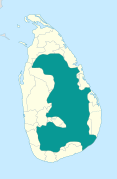
|
Size: 36–53 cm (14–21 in) long, plus at least 36–53 cm (14–21 in) tail[96] Habitat: Forest[97] Diet: Fruit as well as tree flowers, buds, and leaves[98] |
EN
|
| Arunachal macaque | M. munzala Madhusudan, Mishra , 2005
|
Eastern Himalayas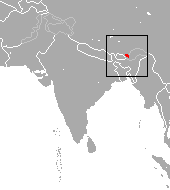
|
Size: 36–77 cm (14–30 in) long, plus about 9–20 cm (4–8 in) tail[96] Habitat: Forest[99] Diet: Fruit, leaves, grains, buds, seeds, flowers, and bark, as well as insects and small invertebrates[96] |
EN
|
| Assam macaque | M. assamensis McClelland, 1840 Two subspecies
|
Southeastern Asia
|
Size: 36–77 cm (14–30 in) long, plus about 9–20 cm (4–8 in) tail[96] Habitat: Forest[100] Diet: Fruit, leaves, grains, buds, seeds, flowers, and bark, as well as insects and small invertebrates[96] |
NT
|
| Barbary macaque | M. sylvanus (Linnaeus, 1758) |
Northwestern Africa
|
Size: 45–60 cm (18–24 in) long, plus 1–2 cm (0–1 in) tail[101] Habitat: Forest, shrubland, grassland, rocky areas, and caves[102] Diet: Plants, caterpillars, fruit, seeds, roots, and fungi[101] |
EN
|
| Bonnet macaque | M. radiata (Geoffroy, 1812) Two subspecies
|
Southern India
|
Size: 36–77 cm (14–30 in) long, plus about 9–20 cm (4–8 in) tail[96] Habitat: Forest, savanna, and shrubland[103] Diet: Fruit, foliage, and insects, as well as bird eggs and lizards[104] |
VU
|
| Booted macaque | M. ochreata (Ogilby, 1841) |
Island of Sulawesi in Indonesia
|
Size: 36–77 cm (14–30 in) long, plus about 1–15 cm (0–6 in) tail[96] Habitat: Forest and savanna[105] Diet: Fruit, leaves, grains, buds, seeds, flowers, and bark, as well as insects and small invertebrates[96] |
VU
|
| Celebes crested macaque | M. nigra (Desmarest, 1822) |
Island of Sulawesi
|
Size: 44–57 cm (17–22 in) long, plus about 2 cm (1 in) tail[106] Habitat: Forest[107] Diet: Fruit, as well as insects, shoots, leaves, and stems[106] |
CR
|
| Crab-eating macaque | M. fascicularis Raffles, 1821 Ten subspecies
|
Southeastern Asia
|
Size: 40–47 cm (16–19 in) long, plus 50–60 cm (20–24 in) tail Habitat: Forest, intertidal marine, caves, inland wetlands, grassland, shrubland, and savanna[108] Diet: Fruit, crabs, flowers, insects, leaves, fungi, grasses, and clay[109] |
EN
|
| Formosan rock macaque | M. cyclopis (Swinhoe, 1862) |
Taiwan
|
Size: 36–45 cm (14–18 in) long, plus 26–46 cm (10–18 in) tail[110] Habitat: Forest[111] Diet: Fruit, leaves, berries, seeds, insects, and small vertebrates, buds, and shoots[110] |
LC
|
| Gorontalo macaque | M. nigrescens (Temminck, 1849) |
Island of Sulawesi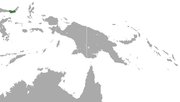
|
Size: 36–77 cm (14–30 in) long, plus about 1–15 cm (0–6 in) tail[96] Habitat: Forest[112] Diet: Fruit, leaves, grains, buds, seeds, flowers, and bark, as well as insects and small invertebrates[96] |
VU
|
| Heck's macaque
|
M. hecki (Matschie, 1901) |
Island of Sulawesi
|
Size: 36–77 cm (14–30 in) long, plus about 1–15 cm (0–6 in) tail[96] Habitat: Forest and grassland[113] Diet: Fruit, leaves, grains, buds, seeds, flowers, and bark, as well as insects and small invertebrates[96] |
VU
|
| Japanese macaque | M. fuscata Blyth, 1875 Two subspecies
|
Japan
|
Size: 36–77 cm (14–30 in) long, plus about 1–15 cm (0–6 in) tail[96] Habitat: Forest[114] Diet: Fruit, seeds, flowers, nectar, leaves, and fungi[115] |
LC
|
| Lion-tailed macaque | M. silenus (Linnaeus, 1758) |
Southwestern India
|
Size: 40–61 cm (16–24 in) long, plus 24–38 cm (9–15 in) tail[116] Habitat: Forest[117] Diet: Fruit, as well as leaves, stems, flowers, buds, fungi, insects, lizards, tree frogs, and small mammals[116] |
EN
|
| Moor macaque | M. maura (Schinz, 1825) |
Island of Sulawesi
|
Size: 36–77 cm (14–30 in) long, plus about 1–15 cm (0–6 in) tail[96] Habitat: Forest and grassland[118] Diet: Fruit, leaves, grains, buds, seeds, flowers, and bark, as well as insects and small invertebrates[96] |
EN
|
| Muna-Buton macaque
|
M. brunnescens (Matschie, 1901) |
Island of Sulawesi in Indonesia
|
Size: 36–77 cm (14–30 in) long, plus about 1–15 cm (0–6 in) tail[96] Habitat: Forest[119] Diet: Fruit, leaves, grains, buds, seeds, flowers, and bark, as well as insects and small invertebrates[96] |
VU
|
| Northern pig-tailed macaque | M. leonina (Blyth, 1863) |
Southeastern Asia
|
Size: 36–77 cm (14–30 in) long, plus about 9–20 cm (4–8 in) tail[96] Habitat: Forest[120] Diet: Leaves, seeds, stems, roots, flowers, bamboo shoots, rice, gums, insects, larvae, termite eggs and spiders[120] |
VU
|
| Pagai Island macaque | M. pagensis (Miller, 1903) |
Mentawai Islands in Indonesia
|
Size: 36–77 cm (14–30 in) long, plus about 9–20 cm (4–8 in) tail[96] Habitat: Forest[121] Diet: Fruit, leaves, grains, buds, seeds, flowers, and bark, as well as insects and small invertebrates[96] |
CR
|
| Rhesus macaque | M. mulatta (Zimmermann, 1790) |
Southern and southeastern Asia
|
Size: 45–64 cm (18–25 in) long, plus 19–32 cm (7–13 in) tail[122] Habitat: Forest, savanna, and shrubland[123] Diet: Fish, crabs, shellfish, bird eggs, honeycombs, crayfish, crabs, spiders, plants, gums and pith[123] |
LC
|
| Siberut macaque
|
M. siberu Fuentes, 1995 |
Siberut island in Indonesia
|
Size: 36–77 cm (14–30 in) long, plus about 9–20 cm (4–8 in) tail[96] Habitat: Forest[124] Diet: Fruit, as well as mushrooms, leaves, crabs, crayfish, pith, sap, shoots and flowers[124] |
EN
|
| Southern pig-tailed macaque | M. nemestrina (Linnaeus, 1766) |
Southeastern Asia
|
Size: 46–57 cm (18–22 in) long, plus 13–26 cm (5–10 in) tail[125] Habitat: Forest and shrubland[126] Diet: Fruit, insects, seeds, leaves, dirt, and fungus, as well as birds, termite eggs and larvae, and river crabs[125] |
EN
|
| Stump-tailed macaque | M. arctoides (Geoffroy, 1831) |
Southeastern Asia
|
Size: 48–65 cm (19–26 in) long, plus 3–7 cm (1–3 in) tail[127] Habitat: Forest[128] Diet: Fruit, seeds, flowers, roots, leaves, frogs, crabs, birds, and bird eggs[127] |
VU
|
| Tibetan macaque | M. thibetana (H. Milne-Edwards, 1870) Four subspecies
|
East China
|
Size: 36–77 cm (14–30 in) long, plus about 1–15 cm (0–6 in) tail[96] Habitat: Forest and caves[129] Diet: Fruit, as well as flowers, berries, seeds, leaves, stems, stalks, and invertebrates[129] |
NT
|
| Tonkean macaque | M. tonkeana (von Meyer, 1899) |
Island of Sulawesi
|
Size: 36–77 cm (14–30 in) long, plus about 1–15 cm (0–6 in) tail[96] Habitat: Forest[130] Diet: Fruit, leaves, grains, buds, seeds, flowers, and bark, as well as insects and small invertebrates[96] |
VU
|
| White-cheeked macaque | M. leucogenys Li, Zhao, Fan, 2015 |
Northeastern India | Size: 36–77 cm (14–30 in) long, plus about 9–20 cm (4–8 in) tail[96] Habitat: Forest[131] Diet: Fruit, leaves, grains, buds, seeds, flowers, and bark, as well as insects and small invertebrates[96] |
EN
|
| Common name | Scientific name and subspecies | Range | Size and ecology | IUCN status and estimated population |
|---|---|---|---|---|
| Drill | M. leucophaeus (F. Cuvier, 1807) Two subspecies
|
Western Africa
|
Size: 61–77 cm (24–30 in) long, plus 5–8 cm (2–3 in) tail[132] Habitat: Forest, savanna, and rocky areas[133] Diet: Omnivorous, primarily fruit and seeds[133] |
EN
|
| Mandrill | M. sphinx (Linnaeus, 1758) |
Western Africa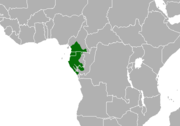
|
Size: 55–95 cm (22–37 in) long, plus 7–10 cm (3–4 in) tail[134] Habitat: Forest[135] Diet: Fruit, seeds, fungi, roots, insects, snails, worms, frogs, and lizards, as well as snakes and small vertebrates[136] |
VU
|
| Common name | Scientific name and subspecies | Range | Size and ecology | IUCN status and estimated population |
|---|---|---|---|---|
| Angolan talapoin | M. talapoin (Schreber, 1774) |
Western Africa
|
Size: 32–45 cm (13–18 in) long, plus 36–53 cm (14–21 in) tail[137] Habitat: Forest and inland wetlands[138] Diet: Insects, leaves, seeds, fruit, water plants, grubs, eggs, and small vertebrates[137] |
VU
|
| Gabon talapoin | M. ogouensis Kingdon, 1997 |
Western Africa
|
Size: 23–36 cm (9–14 in) long, plus 31–45 cm (12–18 in) tail[139] Habitat: Forest[140] Diet: Fruit, seeds and insects[140] |
NT
|
| Common name | Scientific name and subspecies | Range | Size and ecology | IUCN status and estimated population |
|---|---|---|---|---|
| Chacma baboon | P. ursinus (Kerr, 1792) Three subspecies
|
Southern Africa
|
Size: 50–115 cm (20–45 in) long, plus 45–72 cm (18–28 in) tail[141] Habitat: Forest, savanna, shrubland, grassland, rocky areas, and desert[142] Diet: Fruit, leaves, gum, insects, eggs, seeds, flowers, grass, roots, tubers, and small vertebrates[141] |
LC
|
| Guinea baboon | P. papio (Desmarest, 1820) |
Western Africa
|
Size: 50–115 cm (20–45 in) long, plus 45–72 cm (18–28 in) tail[143] Habitat: Forest, savanna, grassland, and inland wetlands[144] Diet: Roots, tubers, bulbs, corms, small vertebrates, fruit, and seeds[143] |
NT
|
| Hamadryas baboon | P. hamadryas (Linnaeus, 1758) |
Horn of Africa and southwestern Arabian Peninsula
|
Size: 61–77 cm (24–30 in) long, plus 38–61 cm (15–24 in) tail[145] Habitat: Shrubland, grassland, and rocky areas[146] Diet: Fruit, gum, insects, eggs, seeds, flowers, grass, rhizomes, corms, roots, tubers, and small vertebrates[145] |
LC
|
| Kinda baboon | P. kindae Lönnberg, 1919 |
Central Africa (in green)
|
Size: 55–84 cm (22–33 in) long, plus 38–66 cm (15–26 in) tail[147] Habitat: Forest, savanna, and shrubland[148] Diet: Omnivorous; primarily fruit[148] |
LC
|
| Olive baboon | P. anubis (Lesson, 1827) |
Equatorial Africa
|
Size: 61–84 cm (24–33 in) long, plus 31–60 cm (12–24 in) tail[149] Habitat: Forest, savanna, shrubland, and grassland[150] Diet: Fruit, gums, insects, eggs, seeds, flowers, grass, rhizomes, corms, roots, tubers, and small vertebrates[151] |
LC
|
| Yellow baboon | P. cynocephalus (Linnaeus, 1766) Two subspecies
|
Eastern Africa (in red)
|
Size: 50–115 cm (20–45 in) long, plus 45–72 cm (18–28 in) tail[152] Habitat: Shrubland, savanna, and forest[153] Diet: Grass, sedges, seeds, fruit, roots, leaves, buds, bark, flowers, insects, and small vertebrates[152] |
LC
|
| Common name | Scientific name and subspecies | Range | Size and ecology | IUCN status and estimated population |
|---|---|---|---|---|
| Kipunji | R. kipunji Jones et al., 2005 |
Southeastern Africa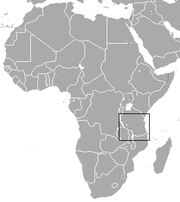
|
Size: 85–90 cm (33–35 in) long, plus about 115 cm (45 in) tail[154] Habitat: Forest[155] Diet: Omnivorous, including bulbs, roots, shoots, seeds, and fruit[154] |
EN
|
| Common name | Scientific name and subspecies | Range | Size and ecology | IUCN status and estimated population |
|---|---|---|---|---|
| Gelada | T. gelada (Rüppell, 1835) Two subspecies
|
Eastern Africa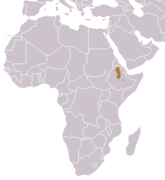
|
Size: 50–75 cm (20–30 in) long, plus 32–55 cm (13–22 in) tail[156] Habitat: Grassland and rocky areas[157] Diet: Leaves and forbs, as well as roots, corms, tubers and rhizomes[157] |
LC
|
Subfamily Colobinae
| Common name | Scientific name and subspecies | Range | Size and ecology | IUCN status and estimated population |
|---|---|---|---|---|
| Angola colobus | C. angolensis P. L. Sclater, 1860 Six subspecies
|
Central Africa
|
Size: 49–68 cm (19–27 in) long, plus 70–83 cm (28–33 in) tail[158] Habitat: Forest[159] Diet: Leaves, as well as stems, bark, flowers, buds, shoots, fruits, and insects[158] |
VU
|
| Black colobus | C. satanas Waterhouse, 1838 Two subspecies
|
Western Africa
|
Size: 50–70 cm (20–28 in) long, plus 62–88 cm (24–35 in) tail[160] Habitat: Forest[161] Diet: Nuts and seeds, as well as unripe fruit and leaves[160] |
VU
|
| King colobus | C. polykomos (Zimmermann, 1780) |
Western Africa
|
Size: 45–72 cm (18–28 in) long, plus 52–100 cm (20–39 in) tail[162] Habitat: Forest and savanna[163] Diet: Leaves, as well as fruit and flowers[162] |
EN
|
| Mantled guereza | C. guereza Rüppell, 1835 Seven subspecies
|
Central Africa
|
Size: 45–72 cm (18–28 in) long, plus 52–100 cm (20–39 in) tail[164] Habitat: Forest[165] Diet: Leaves, as well as fruit, buds, and blossoms[164] |
LC
|
| Ursine colobus | C. vellerosus (Geoffroy, 1834) |
Western Africa
|
Size: 60–67 cm (24–26 in) long, plus 73–93 cm (29–37 in) tail[166] Habitat: Forest[167] Diet: Leaves and seeds, as well as fruit, insects, and clay[168] |
CR
|
| Common name | Scientific name and subspecies | Range | Size and ecology | IUCN status and estimated population |
|---|---|---|---|---|
| Proboscis monkey | N. larvatus Wurmb, 1787 |
Borneo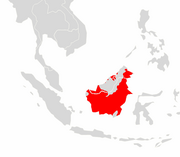
|
Size: 61–76 cm (24–30 in) long, plus 50–75 cm (20–30 in) tail[169] Habitat: Forest[170] Diet: Fruit, seeds, leaves, and shoots, as well as caterpillars and larvae[171] |
EN
|
| Common name | Scientific name and subspecies | Range | Size and ecology | IUCN status and estimated population |
|---|---|---|---|---|
| Bouvier's red colobus
|
P. bouvieri (Rochebrune, 1887) |
Congo (in purple on left)
|
Size: 41–70 cm (16–28 in) long, plus 42–80 cm (17–31 in) tail[172] Habitat: Forest[173] Diet: Fruit, seeds, and leaves[172] |
EN
|
| Foa's red colobus
|
P. foai (Pousargues, 1899) |
Congo (in black, bottom right)
|
Size: 41–70 cm (16–28 in) long, plus 42–80 cm (17–31 in) tail[172] Habitat: Forest[174] Diet: Fruit, seeds, and leaves[172] |
EN
|
| Lomami red colobus
|
P. parmentieri (Colyn, Verheyen, 1987) |
Congo
|
Size: 41–70 cm (16–28 in) long, plus 42–80 cm (17–31 in) tail[172] Habitat: Forest[175] Diet: Fruit, seeds, and leaves[172] |
EN
|
| Lang's red colobus
|
P. langi (J. A. Allen, 1925) |
Congo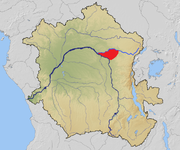
|
Size: 41–70 cm (16–28 in) long, plus 42–80 cm (17–31 in) tail[172] Habitat: Forest[176] Diet: Fruit, seeds, and leaves[172] |
EN
|
| Miss Waldron's red colobus
|
P. waldronae (Hayman, 1936) |
Western Africa
|
Size: 47–63 cm (19–25 in) long, plus 52–75 cm (20–30 in) tail[177] Habitat: Forest[178] Diet: Fruit, seeds, leaves, buds, and flowers[177] |
CR
|
| Niger Delta red colobus
|
P. epieni (Grubb, Powell, 1999) |
Western Africa | Size: 41–70 cm (16–28 in) long, plus 42–80 cm (17–31 in) tail[172] Habitat: Forest[179] Diet: Fruit, seeds, and leaves[172] |
CR
|
| Oustalet's red colobus
|
P. oustaleti (Trouessart, 1906) |
Congo (in green)
|
Size: 41–70 cm (16–28 in) long, plus 42–80 cm (17–31 in) tail[172] Habitat: Forest[180] Diet: Fruit, seeds, and leaves[172] |
VU
|
| Pennant's colobus | P. pennantii (Waterhouse, 1838) |
Western Africa
|
Size: 53–63 cm (21–25 in) long, plus 60–70 cm (24–28 in) tail[181] Habitat: Forest[182] Diet: Leaves and shoots, as well as seeds and fruit[181] |
CR
|
| Preuss's red colobus | P. preussi (Matschie, 1900) |
Western Africa
|
Size: 41–70 cm (16–28 in) long, plus 42–80 cm (17–31 in) tail[172] Habitat: Forest[183] Diet: Fruit, seeds, and leaves[172] |
CR
|
| Semliki red colobus
|
P. semlikiensis (Colyn, 1991) |
Congo (in dark blue on right)
|
Size: 41–70 cm (16–28 in) long, plus 42–80 cm (17–31 in) tail[172] Habitat: Forest[184] Diet: Fruit, seeds, and leaves[172] |
VU
|
| Tana River red colobus | P. rufomitratus (Peters, 1879) |
Kenya | Size: 45–67 cm (18–26 in) long, plus 52–80 cm (20–31 in) tail[185] Habitat: Forest, shrubland, and inland wetlands[186] Diet: Leaves, fruit, and seeds, as well as flowers[185] |
CR
|
| Thollon's red colobus
|
P. tholloni (A. Milne-Edwards, 1886) |
Congo (in orange)
|
Size: 41–70 cm (16–28 in) long, plus 42–80 cm (17–31 in) tail[172] Habitat: Forest[187] Diet: Leaves, fruit, and seeds, as well as flowers[187] |
VU
|
| Udzungwa red colobus | P. gordonorum (Matschie, 1900) |
Southeastern Africa
|
Size: 41–70 cm (16–28 in) long, plus 42–80 cm (17–31 in) tail[172] Habitat: Forest[188] Diet: Fruit, seeds, and leaves[172] |
VU
|
| Ugandan red colobus | P. tephrosceles Elliot, 1907 |
Eastern Africa
|
Size: 41–70 cm (16–28 in) long, plus 42–80 cm (17–31 in) tail[172] Habitat: Forest and savanna[189] Diet: Fruit, seeds, and leaves[172] |
EN
|
| Western red colobus | P. badius (Kerr, 1792) Three subspecies
|
Western Africa
|
Size: 45–67 cm (18–26 in) long, plus 52–80 cm (20–31 in) tail Habitat: Forest and savanna[190] Diet: Leaves, seeds, unripe fruit, and shoots[191] |
EN
|
| Zanzibar red colobus | P. kirkii (Gray, 1868) |
Eastern Africa
|
Size: 41–70 cm (16–28 in) long, plus 42–80 cm (17–31 in) tail[172] Habitat: Forest and shrubland[192] Diet: Leaves, fruit, and seeds, as well as flowers[193] |
EN
|
| Common name | Scientific name and subspecies | Range | Size and ecology | IUCN status and estimated population |
|---|---|---|---|---|
| Black Sumatran langur
|
P. sumatranus (S. Müller, Schlegel, 1841) |
Island of Sumatra in Indonesia | Size: 42–61 cm (17–24 in) long, plus 50–85 cm (20–33 in) tail[194] Habitat: Forest[195] Diet: Fruit, leaves, seeds and flowers[195] |
EN
|
| Black-and-white langur
|
P. bicolor Aimi, Bakar, 1992 |
Island of Sumatra | Size: 42–61 cm (17–24 in) long, plus 50–85 cm (20–33 in) tail[194] Habitat: Forest[196] Diet: Fruit, seeds, and leaves[194] |
DD
|
| Black-crested Sumatran langur | P. melalophos (Raffles, 1821) |
Island of Sumatra
|
Size: 42–61 cm (17–24 in) long, plus 50–85 cm (20–33 in) tail[194] Habitat: Forest and shrubland[197] Diet: Fruits and leaves, as well as seeds and flowers[198] |
EN
|
| East Sumatran banded langur
|
P. percura Lyon, 1908 |
Island of Sumatra | Size: 42–61 cm (17–24 in) long, plus 50–85 cm (20–33 in) tail[194] Habitat: Forest[199] Diet: Fruit, seeds, and leaves[194] |
CR
|
| Hose's langur | P. hosei (Thomas, 1889) |
Borneo
|
Size: 42–61 cm (17–24 in) long, plus 50–85 cm (20–33 in) tail[194] Habitat: Forest[200] Diet: Leaves, unripe fruits, seeds, flowers, bird eggs and nestlings[200] |
VU
|
| Javan surili | P. comata (Desmarest, 1822) Two subspecies
|
Island of Java in Indonesia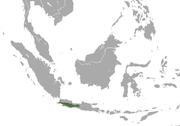
|
Size: 42–61 cm (17–24 in) long, plus 50–85 cm (20–33 in) tail[194] Habitat: Forest[201] Diet: Leaves, as well as fruits, flowers, and seeds[201] |
VU
|
| Maroon leaf monkey | P. rubicunda (Müller, 1838) Five subspecies
|
Borneo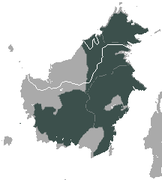
|
Size: 42–61 cm (17–24 in) long, plus 50–85 cm (20–33 in) tail[194] Habitat: Forest and inland wetlands[202] Diet: Leaves, seeds, and fruit, as well as flowers and pith[202] |
VU
|
| Siberut langur | P. siberu (Chasen, Kloss, 1928) |
Island of Siberut in Indonesia
|
Size: 42–61 cm (17–24 in) long, plus 50–85 cm (20–33 in) tail[194] Habitat: Forest[203] Diet: Fruit, seeds, and leaves[194] |
EN
|
| Mentawai langur
|
P. potenziani (Bonaparte, 1856) |
Mentawai islands in Indonesia
|
Size: 42–61 cm (17–24 in) long, plus 50–85 cm (20–33 in) tail[194] Habitat: Forest[204] Diet: Fruit, seeds, and leaves[194] |
CR
|
| Miller's langur | P. canicrus G. S. Miller, 1934 |
Eastern Borneo (in light green)
|
Size: 42–61 cm (17–24 in) long, plus 50–85 cm (20–33 in) tail[194] Habitat: Forest[205] Diet: Fruit, seeds, and leaves[194] |
EN
|
| Mitered langur
|
P. mitrata Eschscholtz, 1821 |
Island of Sumatra | Size: 42–61 cm (17–24 in) long, plus 50–85 cm (20–33 in) tail[194] Habitat: Forest[206] Diet: Fruit, seeds, and leaves[194] |
VU
|
| Natuna Island surili
|
P. natunae (Thomas, Hartert, 1894) |
Island of Natuna Besar in Indonesia
|
Size: 42–61 cm (17–24 in) long, plus 50–85 cm (20–33 in) tail[194] Habitat: Forest[207] Diet: Fruit, seeds, and leaves[194] |
VU
|
| Raffles' banded langur | P. femoralis (Martin, 1838) |
Singapore and southern Peninsular Malaysia
|
Size: 42–61 cm (17–24 in) long, plus 50–85 cm (20–33 in) tail[194] Habitat: Forest[208] Diet: Fruit, seeds, and leaves[194] |
CR
|
| Robinson's banded langur | P. robinsoni Thomas, 1910 |
Southern Malay Peninsula
|
Size: 42–61 cm (17–24 in) long, plus 50–85 cm (20–33 in) tail[194] Habitat: Forest[209] Diet: Fruit, seeds, and leaves[194] |
NT
|
| Sabah grizzled langur
|
P. sabana (Thomas, 1893) |
Eastern Borneo (in dark brown)
|
Size: 42–61 cm (17–24 in) long, plus 50–85 cm (20–33 in) tail[194] Habitat: Forest[210] Diet: Fruit, seeds, and leaves[194] |
EN
|
| Sarawak surili | P. chrysomelas (Müller, 1838) Two subspecies
|
Northern Borneo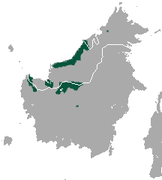
|
Size: 42–61 cm (17–24 in) long, plus 50–85 cm (20–33 in) tail[194] Habitat: Forest[211] Diet: Fruit, seeds, and leaves[194] |
CR
|
| Thomas's langur | P. thomasi (Collett, 1893) |
Northern island of Sumatra in Indonesia
|
Size: 42–62 cm (17–24 in) long, plus 50–85 cm (20–33 in) tail[212] Habitat: Forest[213] Diet: Fruit, leaves, and seeds, as well as flowers, bark, twigs, stalks, birds, bird eggs, algae, and insects[212] |
VU
|
| White-fronted surili | P. frontata (Müller, 1838) |
Borneo
|
Size: 42–61 cm (17–24 in) long, plus 50–85 cm (20–33 in) tail[194] Habitat: Forest[214] Diet: Fruit, seeds, and leaves[194] |
VU
|
| White-thighed surili | P. siamensis (Müller, Schlegel, 1838) Four subspecies
|
Southeastern Asia
|
Size: 42–61 cm (17–24 in) long, plus 50–85 cm (20–33 in) tail[194] Habitat: Forest[215] Diet: Fruit, seeds, and leaves[194] |
NT
|
| Common name | Scientific name and subspecies | Range | Size and ecology | IUCN status and estimated population |
|---|---|---|---|---|
| Olive colobus | P. verus (Van Beneden, 1838) |
Western Africa
|
Size: 43–50 cm (17–20 in) long, plus 57–64 cm (22–25 in) tail[216] Habitat: Forest[217] Diet: Leaves and flowers[218] |
VU
|
| Common name | Scientific name and subspecies | Range | Size and ecology | IUCN status and estimated population |
|---|---|---|---|---|
| Black-shanked douc | P. nigripes H. Milne-Edwards, 1871 |
Southeastern Asia
|
Size: 60–76 cm (24–30 in) long, plus 56–76 cm (22–30 in) tail[219] Habitat: Forest[220] Diet: Leaves, as well as seeds, fruit and flowers[220] |
CR
|
| Gray-shanked douc | P. cinerea ( Nadler , 1997)
|
Southeastern Asia
|
Size: About 60 cm (24 in) long, plus 59–68 cm (23–27 in) tail[219] Habitat: Forest[221] Diet: Leaves, as well as buds, fruit, seeds, and flowers[222] |
CR
|
| Red-shanked douc | P. nemaeus (Linnaeus, 1771) |
Southeastern Asia
|
Size: 61–77 cm (24–30 in) long, plus 55–77 cm (22–30 in) tail[223] Habitat: Forest[224] Diet: Leaves, as well as unripe fruit, seeds, and flowers[223] |
CR
|
| Common name | Scientific name and subspecies | Range | Size and ecology | IUCN status and estimated population |
|---|---|---|---|---|
| Black-and-white snub-nosed monkey | R. bieti (A. Milne-Edwards, 1897) |
Southern China
|
Size: 74–83 cm (29–33 in) long, plus 51–72 cm (20–28 in) tail[225] Habitat: Forest[226] Diet: Leaves, fruit, and lichen[225] |
EN
|
| Golden snub-nosed monkey | R. roxellana A. Milne-Edwards, 1870 Three subspecies
|
Central China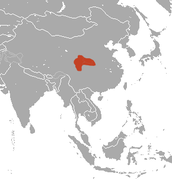
|
Size: 57–76 cm (22–30 in) long, plus 51–72 cm (20–28 in) tail[227] Habitat: Forest[228] Diet: Leaves, bark, and lichen, as well as buds and fruit seeds[227] |
EN
|
| Gray snub-nosed monkey | R. brelichi Thomas, 1903 |
Central China
|
Size: 64–73 cm (25–29 in) long, plus 70–97 cm (28–38 in) tail[229] Habitat: Forest[230] Diet: Leaves, buds, fruit, seeds and bark, as well as insect larvae[229] |
CR
|
| Myanmar snub-nosed monkey | R. strykeri Geissmann et al., 2010 |
Northern Myanmar
|
Size: About 56 cm (22 in) long, plus 78 cm (31 in) tail[231] Habitat: Forest[232] Diet: Leaves, fruit, seeds, buds, flowers, twigs, and bark[233] |
CR
|
| Tonkin snub-nosed monkey | R. avunculus (Dollman, 1912) |
Northern Vietnam
|
Size: 51–65 cm (20–26 in) long, plus 66–92 cm (26–36 in) tail[234] Habitat: Forest[235] Diet: Leaves, fruit, flowers, and seeds[234] |
CR
|
| Common name | Scientific name and subspecies | Range | Size and ecology | IUCN status and estimated population |
|---|---|---|---|---|
| Black-footed gray langur | S. hypoleucos Blyth, 1841 Three subspecies
|
Southern India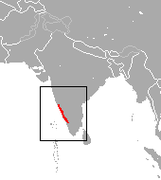
|
Size: 41–78 cm (16–31 in) long, plus 69–108 cm (27–43 in) tail[236] Habitat: Forest and shrubland[237] Diet: Leaves, fruit, and flowers[236] |
LC
|
| Kashmir gray langur
|
S. ajax Pocock, 1928 |
Himalayas
|
Size: 41–78 cm (16–31 in) long, plus 69–108 cm (27–43 in) tail[236] Habitat: Forest[238] Diet: Leaves, bark, and seeds[238] |
EN
|
| Nepal gray langur | S. schistaceus Hodgson, 1840 |
Southern India
|
Size: 41–78 cm (16–31 in) long, plus 69–108 cm (27–43 in) tail[236] Habitat: Forest, shrubland, and rocky areas[239] Diet: Leaves and fruit, as well as seeds, roots, flowers, bark, twigs, coniferous cones, moss, lichens, ferns, shoots, rhizomes, grass, and invertebrate animals[239] |
LC
|
| Nilgiri langur | S. johnii (J. Fischer, 1829) |
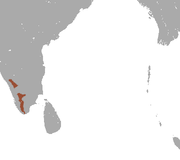
|
Size: 41–78 cm (16–31 in) long, plus 69–108 cm (27–43 in) tail[236] Habitat: Forest[240] Diet: Leaves, fruit, and flowers[236] |
VU
|
| Northern plains gray langur | S. entellus (Dufresne, 1797) |
India
|
Size: 41–78 cm (16–31 in) long, plus 69–108 cm (27–43 in) tail[236] Habitat: Forest, savanna, and shrubland[241] Diet: Leaves, fruit, and flowers, as well as insects, bark, gum, and soil[242] |
LC
|
| Tarai gray langur | S. hector Pocock, 1928 |
Himalayas
|
Size: 41–78 cm (16–31 in) long, plus 69–108 cm (27–43 in) tail[236] Habitat: Forest[243] Diet: Leaves, fruit, and flowers[236] |
NT
|
| Tufted gray langur | S. priam Blyth, 1844 Three subspecies
|
Southern India and Sri Lanka
|
Size: 41–78 cm (16–31 in) long, plus 69–108 cm (27–43 in) tail[236] Habitat: Forest and shrubland[244] Diet: Leaves and fruit[244] |
NT
|
| Purple-faced langur | S. vetulus (Erxleben, 1777) Four subspecies
|
Sri Lanka
|
Size: 41–78 cm (16–31 in) long, plus 69–108 cm (27–43 in) tail[236] Habitat: Forest[245] Diet: Leaves, fruit, flowers, and seeds[245] |
EN
|
| Common name | Scientific name and subspecies | Range | Size and ecology | IUCN status and estimated population |
|---|---|---|---|---|
| Pig-tailed langur | S. concolor Miller, 1903 Three subspecies
|
Islands near Sumatra in Indonesia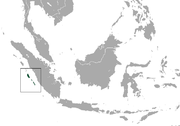
|
Size: 45–53 cm (18–21 in) long, plus 13–18 cm (5–7 in) tail[246] Habitat: Forest[247] Diet: Leaves, fruit, and berries[248] |
CR
|
| Common name | Scientific name and subspecies | Range | Size and ecology | IUCN status and estimated population |
|---|---|---|---|---|
| Annamese langur | T. margarita (Elliot, 1909) |
Southeastern Asia
|
Size: 40–76 cm (16–30 in) long, plus 57–110 cm (22–43 in) tail[249] Habitat: Forest[250] Diet: Leaves, flowers, and fruit[249] |
EN
|
| Capped langur | T. pileatus (Blyth, 1843) Three subspecies
|
Southern Asia
|
Size: 40–76 cm (16–30 in) long, plus 57–110 cm (22–43 in) tail[249] Habitat: Forest[251] Diet: Leaves, seeds, and fruit, as well as flowers, buds, bark, and caterpillars[251] |
VU
|
| Cat Ba langur | T. poliocephalus (Pousargues, 1898) |
Cát Bà Island, Vietnam (in purple)
|
Size: 40–76 cm (16–30 in) long, plus 57–110 cm (22–43 in) tail[249] Habitat: Forests and caves[252] Diet: Leaves, flowers, and fruit[249] |
CR
|
| Delacour's langur | T. delacouri (Osgood, 1911) |
Northern Vietnam
|
Size: 40–76 cm (16–30 in) long, plus 57–110 cm (22–43 in) tail[249] Habitat: Forest, rocky areas, and caves[253] Diet: Leaves, flowers, and fruit[249] |
CR
|
| Dusky leaf monkey | T. obscurus (Reid, 1837) Seven subspecies
|
Southeastern Asia
|
Size: 42–61 cm (17–24 in) long, plus 50–85 cm (20–33 in) tail[254] Habitat: Forest[255] Diet: Leaves, shoots, fruit, and seedlings[254] |
EN
|
| East Javan langur | T. auratus Geoffroy, 1812 |
Java and nearby islands in Indonesia
|
Size: 44–65 cm (17–26 in) long, plus 61–87 cm (24–34 in) tail[256] Habitat: Forest[257] Diet: Leaves and flowers, as well as fruit and insect larvae[256] |
VU
|
| François' langur | T. francoisi (Pousargues, 1898) |
Southern Asia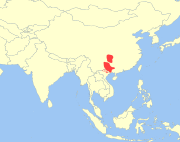
|
Size: 40–76 cm (16–30 in) long, plus 57–110 cm (22–43 in) tail[249] Habitat: Forest, rocky areas, and caves[258] Diet: Leaves, fruit, and seeds, as well as insects[259] |
EN
|
| Gee's golden langur | T. geei (Khajuria, 1956) |
Southern Asia
|
Size: 50–75 cm (20–30 in) long, plus 70–100 cm (28–39 in) tail[260] Habitat: Forest[261] Diet: Fruit, leaves, flowers, seeds, and twigs[260] |
EN
|
| Germain's langur | T. germaini (H. Milne-Edwards, 1876) |
Southeastern Asia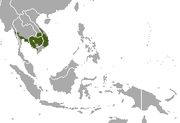
|
Size: 40–76 cm (16–30 in) long, plus 57–110 cm (22–43 in) tail[249] Habitat: Forest and rocky areas[262] Diet: Leaves, fruit, and flowers[262] |
EN
|
| Hatinh langur | T. hatinhensis (Dao, 1970) |
Vietnam
|
Size: 40–76 cm (16–30 in) long, plus 57–110 cm (22–43 in) tail[249] Habitat: Forest, rocky areas, and caves[263] Diet: Leaves, as well as fruit, vines, and flowers[263] |
EN
|
| Indochinese black langur
|
T. ebenus Brandon-Jones, 1995 |
Southeastern Asia | Size: 40–76 cm (16–30 in) long, plus 57–110 cm (22–43 in) tail[249] Habitat: Forest, rocky areas, and caves[264] Diet: Leaves, as well as fruit, vines, and flowers[264] |
EN
|
| Indochinese grey langur | T. crepuscula (Elliot, 1909) |
Southeast Asia (in red)
|
Size: 40–76 cm (16–30 in) long, plus 57–110 cm (22–43 in) tail[249] Habitat: Forest, inland wetlands, and rocky areas[265] Diet: Leaves, flowers, and fruit[249] |
EN
|
| Laotian langur | T. laotum (Thomas, 1911) |
Laos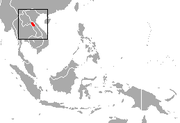
|
Size: 40–76 cm (16–30 in) long, plus 57–110 cm (22–43 in) tail[249] Habitat: Forest and rocky areas[266] Diet: Leaves, flowers, and fruit[249] |
EN
|
| Phayre's leaf monkey | T. phayrei (Blyth, 1847) Two subspecies
|
Southeast Asia (in green)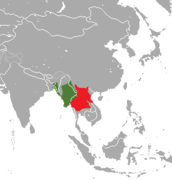
|
Size: 40–76 cm (16–30 in) long, plus 57–110 cm (22–43 in) tail[249] Habitat: Forest[267] Diet: Leaves, as well as bamboo shoots[268] |
EN
|
| Popa langur
|
T. popa Roos et al., 2020 |
Myanmar
|
Size: 40–76 cm (16–30 in) long, plus 57–110 cm (22–43 in) tail[249] Habitat: Forest[269] Diet: Leaves, flowers, and fruit[249] |
CR
|
| Shortridge's langur | T. shortridgei Wroughton, 1915 |
Southern Asia
|
Size: 40–76 cm (16–30 in) long, plus 57–110 cm (22–43 in) tail[249] Habitat: Forest[270] Diet: Leaves, flowers, and fruit[249] |
EN
|
| Selangor silvered langur | T. selangorensis Roos, Nadler, Walter, 2008 |
Peninsular Malaysia | Size: 40–76 cm (16–30 in) long, plus 57–110 cm (22–43 in) tail[249] Habitat: Forest[271] Diet: Leaves, flowers, and fruit[249] |
NT
|
| Silvery lutung | T. cristatus Raffles, 1821 Two subspecies
|
Southeastern Asia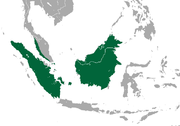
|
Size: 46–56 cm (18–22 in) long, plus 63–84 cm (25–33 in) tail[272] Habitat: Forest[273] Diet: Leaves, as well as fruit, seeds, shoots, flowers, and buds[272] |
VU
|
| Tenasserim lutung
|
T. barbei (Blyth, 1847) |
Southeastern Asia
|
Size: 40–76 cm (16–30 in) long, plus 57–110 cm (22–43 in) tail[249] Habitat: Forest[274] Diet: Leaves, flowers, and fruit[249] |
VU
|
| West Javan langur | T. mauritius (Griffith, 1821) |
Island of Java | Size: 40–76 cm (16–30 in) long, plus 57–110 cm (22–43 in) tail[249] Habitat: Forest[275] Diet: Leaves, flowers, and fruit[249] |
VU
|
| White-headed langur | T. leucocephalus Tan, 1957 |
Southern China | Size: 40–76 cm (16–30 in) long, plus 57–110 cm (22–43 in) tail[249] Habitat: Rocky areas[276] Diet: Leaves, flowers, and fruit[249] |
CR
|
References
- ^ "Fossilworks: Cercopithecoidea". Paleobiology Database. University of Wisconsin–Madison. Archived from the original on August 11, 2023. Retrieved August 10, 2023.
- PMID 21436896.
- ^ Wilson, Reeder, pp. 152–177
- ^ Kingdon 2015, p. 143
- ^ .
- ^ Sides, Corey (2023). "Allenopithecus nigroviridis". Animal Diversity Web. University of Michigan. Archived from the original on July 24, 2023. Retrieved July 24, 2023.
- ^ a b Ferguson, Bess (2011). "Cercopithecus lhoesti". Animal Diversity Web. University of Michigan. Archived from the original on July 24, 2023. Retrieved July 24, 2023.
- ^ .
- ^ a b Kingdon 2015, p. 156
- ^ .
- ^ a b Kingdon 2015, p. 157
- ^ .
- ^ Kingdon 2015, p. 136
- ^ .
- ^ a b c Kingdon 2015, p. 134
- ^ .
- ^ a b Patterson, Haley (2017). "Cercocebus chrysogaster". Animal Diversity Web. University of Michigan. Archived from the original on August 12, 2023. Retrieved July 24, 2023.
- ^ .
- ^ Kingdon 2015, p. 137
- ^ .
- ^ a b Lee, Scarlett (2012). "Cercocebus atys". Animal Diversity Web. University of Michigan. Archived from the original on July 24, 2023. Retrieved July 24, 2023.
- ^ .
- ^ a b Mittl, Gregory (2011). "Cercocebus galeritus". Animal Diversity Web. University of Michigan. Archived from the original on August 12, 2023. Retrieved July 24, 2023.
- ^ .
- ^ .
- ^ Kingdon 2014, p. 184
- ^ Kingdon 2015, p. 175
- ^ .
- ^ Strawder, Nicole (2001). "Cercopithecus mitis". Animal Diversity Web. University of Michigan. Archived from the original on August 12, 2023. Retrieved July 24, 2023.
- ^ a b Leinberger, Kaitlynn (2022). "Cercopithecus campbelli". Animal Diversity Web. University of Michigan. Archived from the original on August 12, 2023. Retrieved July 24, 2023.
- ^ .
- ^ Kingdon 2015, p. 168
- ^ .
- ^ Kingdon 2015, p. 161
- ^ .
- ^ Stein, Joshua (2002). "Cercopithecus neglectus". Animal Diversity Web. University of Michigan. Archived from the original on June 26, 2023. Retrieved August 16, 2023.
- ^ Kingdon 2015, p. 166
- ^ .
- ^ a b Kennedy, Karen (2023). "Cercopithecus diana". Animal Diversity Web. University of Michigan. Archived from the original on March 6, 2016. Retrieved July 24, 2023.
- ^ .
- ^ Kingdon 2015, p. 174
- ^ .
- ^ Neinast, Alexandra (2012). "Cercopithecus nictitans". Animal Diversity Web. University of Michigan. Archived from the original on July 26, 2023. Retrieved August 16, 2023.
- ^ Kingdon 2015, p. 170
- ^ .
- ^ Bharti, Nita (2000). "Cercopithecus hamlyni". Animal Diversity Web. University of Michigan. Archived from the original on July 24, 2023. Retrieved July 24, 2023.
- ^ a b c Kingdon 2015, p. 179
- ^ .
- ^ Kingdon 2015, p. 171
- ^ .
- ^ Antosh, Bonnie (2013). "Cercopithecus lomamiensis". Animal Diversity Web. University of Michigan. Archived from the original on August 16, 2023. Retrieved August 16, 2023.
- ^ a b Kingdon 2015, p. 165
- ^ .
- ^ a b Liu, Sonia (2000). "Cercopithecus mona". Animal Diversity Web. University of Michigan. Archived from the original on February 20, 2023. Retrieved July 24, 2023.
- ^ .
- ^ Kingdon 2015, p. 181
- ^ .
- ^ Miretti, Juan (2006). "Cercopithecus cephus". Animal Diversity Web. University of Michigan. Archived from the original on July 24, 2023. Retrieved July 24, 2023.
- ^ Kingdon 2015, p. 182
- ^ .
- ^ Kingdon 2015, p. 183
- ^ .
- ^ Davis, Sarah (2002). "Cercopithecus ascanius". Animal Diversity Web. University of Michigan. Archived from the original on April 1, 2023. Retrieved July 24, 2023.
- ^ a b Johnson, Kelsey (2015). "Cercopithecus roloway". Animal Diversity Web. University of Michigan. Archived from the original on June 18, 2021. Retrieved July 24, 2023.
- ^ .
- ^ Kingdon 2015, p. 180
- ^ .
- ^ Law, Jason (2004). "Cercopithecus sclateri". Animal Diversity Web. University of Michigan. Archived from the original on July 26, 2023. Retrieved August 16, 2023.
- ^ .
- ^ a b Platter, Branden (2008). "Cercopithecus wolfi". Animal Diversity Web. University of Michigan. Archived from the original on July 24, 2023. Retrieved July 24, 2023.
- ^ .
- ^ a b Kingdon 2015, p. 152
- ^ .
- ^ Kingdon 2014, p. 289
- ^ Kingdon 2015, p. 158
- ^ .
- ^ .
- ^ Keller, Matthew (2010). "Chlorocebus sabaeus". Animal Diversity Web. University of Michigan. Archived from the original on July 24, 2023. Retrieved July 24, 2023.
- ^ a b Rochester, Melissa Jill (2023). "Chlorocebus aethiops". Animal Diversity Web. University of Michigan. Archived from the original on April 1, 2023. Retrieved August 16, 2023.
- ^ .
- ^ a b Kingdon 2014, p. 286
- ^ .
- ^ a b c Kingdon 2015, p. 151
- ^ .
- ^ .
- ^ Kingdon 2014, p. 279
- ^ a b c d Kingdon 2014, pp. 259, 264
- ^ .
- ^ a b Bonadio, Christopher (2000). "Erythrocebus patas". Animal Diversity Web. University of Michigan. Archived from the original on August 12, 2023. Retrieved July 24, 2023.
- ^ .
- ^ .
- ^ a b Kingdon 2015, p. 126
- ^ .
- ^ Kingdon 2015, p. 125
- ^ .
- ^ a b c d e f g h i j k l m n o p q r s t u v w x y z Nowak 1999b, pp. 140, 142
- ^ .
- ^ Kanelos, Matthew (2009). "Macaca sinica". Animal Diversity Web. University of Michigan. Archived from the original on June 7, 2023. Retrieved July 24, 2023.
- ^ .
- ^ .
- ^ a b Jinn, Judy (2011). "Macaca sylvanus". Animal Diversity Web. University of Michigan. Archived from the original on July 24, 2023. Retrieved July 24, 2023.
- ^ .
- ^ .
- ^ Brown, Monica (2008). "Macaca radiata". Animal Diversity Web. University of Michigan. Archived from the original on April 1, 2023. Retrieved August 16, 2023.
- ^ .
- ^ a b Bichell, Rae Ellen (2011). "Macaca nigra". Animal Diversity Web. University of Michigan. Archived from the original on July 24, 2023. Retrieved July 24, 2023.
- ^ .
- ^ .
- ^ Bonadio, Christopher (2000). "Macaca fascicularis". Animal Diversity Web. University of Michigan. Archived from the original on August 12, 2023. Retrieved July 24, 2023.
- ^ a b Chiu, Crystal (2001). "Macaca cyclopis". Animal Diversity Web. University of Michigan. Archived from the original on August 30, 2023. Retrieved July 24, 2023.
- ^ .
- ^ .
- ^ .
- ^ .
- ^ hardman, brandon (2011). "Macaca fuscata". Animal Diversity Web. University of Michigan. Archived from the original on August 12, 2023. Retrieved July 24, 2023.
- ^ a b Strawder, Nicole (2001). "Macaca silenus". Animal Diversity Web. University of Michigan. Archived from the original on August 12, 2023. Retrieved July 24, 2023.
- ^ .
- ^ .
- ^ .
- ^ .
- ^ .
- ^ Seinfeld, Joshua (2000). "Macaca mulatta". Animal Diversity Web. University of Michigan. Archived from the original on August 16, 2023. Retrieved August 16, 2023.
- ^ .
- ^ .
- ^ a b Ayers, Kayla; Vanderpoel, Candace (2009). "Macaca nemestrina". Animal Diversity Web. University of Michigan. Archived from the original on April 15, 2023. Retrieved August 16, 2023.
- ^ .
- ^ a b Erfurth, Charlotte (2008). "Macaca arctoides". Animal Diversity Web. University of Michigan. Archived from the original on July 24, 2023. Retrieved July 24, 2023.
- ^ .
- ^ .
- ^ .
- ^ .
- ^ Briercheck, Ken (2023). "Mandrillus leucophaeus". Animal Diversity Web. University of Michigan. Archived from the original on July 18, 2023. Retrieved August 16, 2023.
- ^ .
- ^ Kingdon 2015, p. 129
- ^ .
- ^ Ingmarsson, Lisa (2023). "Mandrillus sphinx". Animal Diversity Web. University of Michigan. Archived from the original on May 15, 2023. Retrieved August 16, 2023.
- ^ a b Frederick, Bridget (2002). "Miopithecus talapoin". Animal Diversity Web. University of Michigan. Archived from the original on November 4, 2022. Retrieved July 24, 2023.
- ^ .
- ^ Kingdon 2015, p. 145
- ^ .
- ^ a b Shefferly, Nancy (2004). "Papio ursinus". Animal Diversity Web. University of Michigan. Archived from the original on July 13, 2023. Retrieved July 24, 2023.
- ^ .
- ^ a b Shefferly, Nancy (2004). "Papio papio". Animal Diversity Web. University of Michigan. Archived from the original on February 10, 2019. Retrieved July 24, 2023.
- ^ .
- ^ a b Shefferly, Nancy (2004). "Papio hamadryas". Animal Diversity Web. University of Michigan. Archived from the original on April 1, 2023. Retrieved July 24, 2023.
- ^ .
- ^ Kingdon 2014, p. 232
- ^ .
- ^ Kingdon 2015, p. 120
- ^ .
- ^ Shefferly, Nancy (2004). "Papio anubis". Animal Diversity Web. University of Michigan. Archived from the original on August 12, 2023. Retrieved July 24, 2023.
- ^ a b Shefferly, Nancy (2004). "Papio cynocephalus". Animal Diversity Web. University of Michigan. Archived from the original on August 12, 2023. Retrieved July 24, 2023.
- ^ .
- ^ a b Kingdon 2015, p. 123
- ^ .
- ^ Kingdon 2015, p. 127
- ^ .
- ^ a b Thompson, Brandon (2002). "Colobus angolensis". Animal Diversity Web. University of Michigan. Archived from the original on August 12, 2023. Retrieved July 24, 2023.
- ^ .
- ^ a b Lane, Whitney (2011). "Colobus satanas". Animal Diversity Web. University of Michigan. Archived from the original on August 12, 2023. Retrieved July 24, 2023.
- ^ .
- ^ a b Landes, Devon (2000). "Colobus polykomos". Animal Diversity Web. University of Michigan. Archived from the original on August 12, 2023. Retrieved July 24, 2023.
- ^ .
- ^ a b Kim, Kenneth (2002). "Colobus guereza". Animal Diversity Web. University of Michigan. Archived from the original on August 12, 2023. Retrieved July 24, 2023.
- ^ .
- ^ Kingdon 2015, p. 114
- ^ .
- ^ Walker, Shannon (2009). "Colobus vellerosus". Animal Diversity Web. University of Michigan. Archived from the original on August 4, 2020. Retrieved July 24, 2023.
- ^ Nowak 1999b, p. 155
- ^ .
- ^ Woltanski, Amy (2004). "Nasalis larvatus". Animal Diversity Web. University of Michigan. Archived from the original on July 23, 2023. Retrieved July 24, 2023.
- ^ a b c d e f g h i j k l m n o p q r s t u v Kingdon 2015, p. 103
- ^ .
- ^ .
- ^ .
- ^ .
- ^ a b Kingdon 2015, p. 110
- ^ .
- ^ .
- ^ .
- ^ a b Gilbert, Kasi (2011). "Piliocolobus pennantii". Animal Diversity Web. University of Michigan. Archived from the original on July 24, 2023. Retrieved July 24, 2023.
- ^ .
- ^ .
- ^ .
- ^ a b Jones, Jeremy (2002). "Piliocolobus rufomitratus". Animal Diversity Web. University of Michigan. Archived from the original on August 12, 2023. Retrieved July 24, 2023.
- ^ .
- ^ .
- ^ .
- ^ .
- ^ .
- ^ Vasselin, Kathleen (2011). "Piliocolobus badius". Animal Diversity Web. University of Michigan. Archived from the original on August 12, 2023. Retrieved July 24, 2023.
- ^ .
- ^ Smit, Josephine (2012). "Piliocolobus kirkii". Animal Diversity Web. University of Michigan. Archived from the original on August 12, 2023. Retrieved July 24, 2023.
- ^ a b c d e f g h i j k l m n o p q r s t u v w x y z aa ab ac ad ae Nowak 1999a, pp. 599–600
- ^ .
- ^ .
- ^ .
- ^ Tedesco, Dana (2006). "Presbytis melalophos". Animal Diversity Web. University of Michigan. Archived from the original on August 12, 2023. Retrieved July 24, 2023.
- ^ .
- ^ .
- ^ .
- ^ .
- ^ .
- ^ .
- ^ .
- ^ .
- ^ .
- ^ .
- ^ .
- ^ .
- ^ .
- ^ a b Matthews, Mika (2004). "Presbytis thomasi". Animal Diversity Web. University of Michigan. Archived from the original on August 12, 2023. Retrieved July 24, 2023.
- ^ .
- ^ .
- ^ .
- ^ Kingdon 2015, p. 102
- ^ .
- ^ Thompson, Leah (2002). "Procolobus verus". Animal Diversity Web. University of Michigan. Archived from the original on August 12, 2023. Retrieved July 24, 2023.
- ^ a b Petter; Desbordes, p. 118
- ^ .
- ^ .
- ^ Berger, Matt (2009). "Pygathrix cinerea". Animal Diversity Web. University of Michigan. Archived from the original on January 24, 2023. Retrieved July 24, 2023.
- ^ a b Hara, Carla (2003). "Pygathrix nemaeus". Animal Diversity Web. University of Michigan. Archived from the original on August 12, 2023. Retrieved July 24, 2023.
- ^ .
- ^ a b Deng, Xin (2020). "Rhinopithecus bieti". Animal Diversity Web. University of Michigan. Archived from the original on August 12, 2023. Retrieved July 24, 2023.
- ^ .
- ^ a b Munoz, Peter (2023). "Rhinopithecus roxellana". Animal Diversity Web. University of Michigan. Archived from the original on August 12, 2023. Retrieved July 24, 2023.
- ^ .
- ^ a b "Grey snub-nosed monkey (Rhinopithecus brelichi)". ARKive. Wildscreen. Archived from the original on September 9, 2015. Retrieved December 16, 2013.
- ^ .
- from the original on June 8, 2023. Retrieved August 24, 2023.
- ^ .
- S2CID 71145324.
- ^ a b Cherka, Rachel (2014). "Rhinopithecus avunculus". Animal Diversity Web. University of Michigan. Archived from the original on August 12, 2023. Retrieved July 24, 2023.
- ^ .
- ^ a b c d e f g h i j k Nowak 1999b, p. 160
- ^ .
- ^ .
- ^ .
- ^ .
- ^ .
- ^ Semke, Rebecca (2011). "Semnopithecus entellus". Animal Diversity Web. University of Michigan. Archived from the original on July 24, 2023. Retrieved July 24, 2023.
- ^ .
- ^ .
- ^ .
- ^ Nowak 1999b, p. 156
- ^ .
- ^ Rankin, Lyndsay (2006). "Simias concolor". Animal Diversity Web. University of Michigan. Archived from the original on August 12, 2023. Retrieved July 24, 2023.
- ^ a b c d e f g h i j k l m n o p q r s t u v w x y z aa ab Nowak 1999a, p. 602
- ^ .
- ^ .
- ^ .
- ^ .
- ^ a b Viswanathan, Lata (2002). "Trachypithecus obscurus". Animal Diversity Web. University of Michigan. Archived from the original on July 9, 2023. Retrieved July 24, 2023.
- ^ .
- ^ a b Cannon, William; Vos, Abby (2009). "Trachypithecus auratus". Animal Diversity Web. University of Michigan. Archived from the original on July 24, 2023. Retrieved July 24, 2023.
- ^ .
- ^ .
- ^ Ris, Lauren (2004). "Trachypithecus francoisi". Animal Diversity Web. University of Michigan. Archived from the original on August 12, 2023. Retrieved July 24, 2023.
- ^ a b Raval, Shivani (2004). "Trachypithecus geei". Animal Diversity Web. University of Michigan. Archived from the original on April 7, 2019. Retrieved July 24, 2023.
- ^ .
- ^ .
- ^ .
- ^ .
- ^ .
- ^ .
- ^ .
- ^ cantwell, wayne (2011). "Trachypithecus phayrei". Animal Diversity Web. University of Michigan. Archived from the original on August 12, 2023. Retrieved July 24, 2023.
- ^ .
- ^ .
- ^ .
- ^ a b Bedore, Christine (2005). "Trachypithecus cristatus". Animal Diversity Web. University of Michigan. Archived from the original on August 12, 2023. Retrieved July 24, 2023.
- ^ .
- ^ .
- ^ .
- ^ .
Sources
- ISBN 978-0-8018-8221-0.
- Kingdon, Jonathan (2014). Mammals of Africa. Vol. II: Primates. ISBN 978-1-4081-8991-7.
- Kingdon, Jonathan (2015). The Kingdon Field Guide to African Mammals (Second ed.). ISBN 978-1-4729-2531-2.
- Nowak, Ronald M. (1999a). Walker's Mammals of the World. Vol. 1. ISBN 978-0-8018-5789-8.
- Nowak, Ronald M. (1999b). Walker's Primates of the World. ISBN 978-0-8018-6251-9.
- Petter, Jean-Jacques; Desbordes, François (2013). Primates of the World: An Illustrated Guide. ISBN 978-0-691-15695-8.

